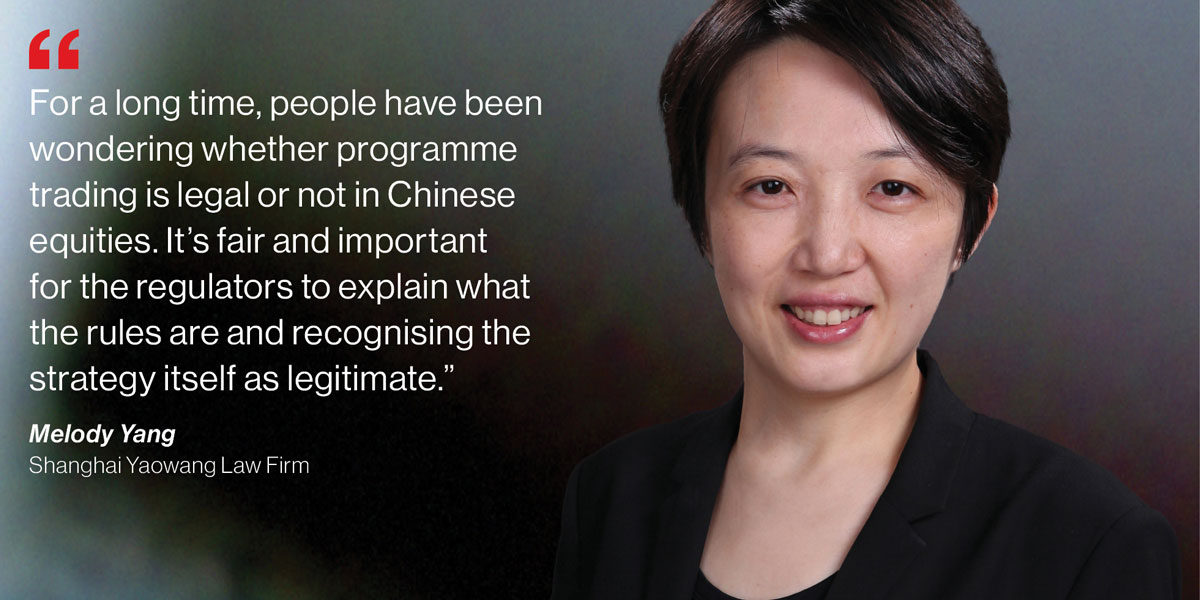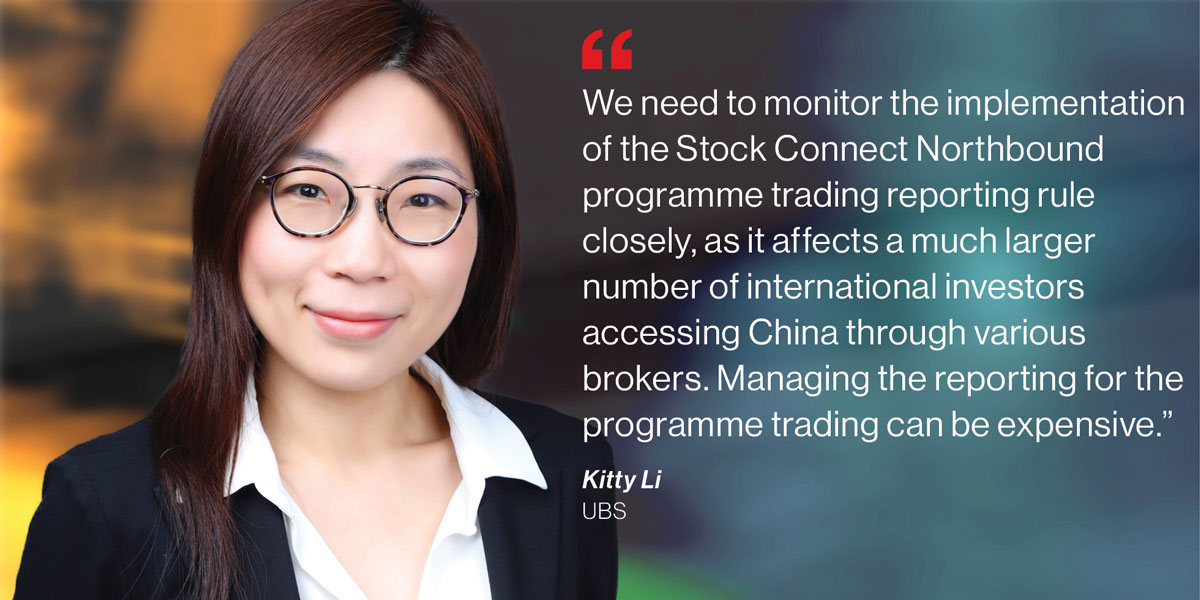Thanks to technology and automotive innovation, the Chinese equity market is re-piquing investors’ interest – but some are concerned about opacity in the region, and restrictive algo trading practices that could make it hard for international investors to get a foot in the door.
Global Trading explores some of the most recent changes that have come into play, considering whether the Chinese equity market is as scary as people think.
Algo trading
In October 2023, China introduced a new slate of algorithmic trading rules with the goal of preventing “abnormal trading activities” and improving overall market stability. Avid support for the changes is voiced by Jacques Lemoisson, founder of Gate Capital Management, who has serious apprehensions about algorithmic trading practices globally.
“In Europe, there are too many algos,” he asserted. “They need visibility of the market to work, and exchanges in the US and Europe allow them to read the order books.
“They can also, and this is concerning from my point of view, populate order books.” He highlights the issue of shadow orders, a form of insider trading whereby investors buy or sell securities with knowledge of companies linked by economic or market factors.
“The issue is that when volatility is going mad, the algo just withdraws its orders,” he adds. “You think that you have plenty of liquidity on the book, and then when you send the order the algo withdraws on you and your order is scratched.”
As such, Lemoisson believes that China’s decision to ramp up algo surveillance was a smart move. “They understood that international – and some local – systematic and algo funds were using their visibility to play against the market.”
“Limiting order book visibility for algos was brilliant, for me. It makes it tougher for the monster firms to be efficient,” he adds. Rather than restrictive, he argues, this is an equalising change.

The Shenzhen and Shanghai exchanges are described by one market participant as “difficult” when it comes to regulation. Guidance sits in a grey area, they say, without clear guidelines on what is and is not permissible.
Melody Yang, funds and regulations partner at Shanghai Yaowang Law Firm (the strategic alliance firm of law firm Simmons & Simmons in China), agrees that algo trading rules have, to date, been evolving yet with certain areas to be further clarified on. “For a long time, people have been wondering whether programme trading is legal or not in Chinese equities,” she says. “It’s fair and important for the regulators to explain what the rules are and recognising the strategy itself as legitimate.”
There is still a way to go though, she adds, with many industry players waiting for further guidance on how they can interact with the market. “Our global clients who really want to use their own algos to generate or execute strategies are going to have to wait for other parts of legislation to come into play before they can meaningfully trade the equities market systematically, for example, the rules on allowing for direct market access (DMA) which was restricted for quite some time,” she says.

Under the updated regulation, algo trading firms are required to disclose a number of details about their models before being allowed to trade on the mainland. The rules are enforced through increased surveillance from onshore brokers and exchanges, including via on or offsite inspections of any algo trading parties at any time. For firms that pride themselves on their secrecy and proprietary technology, this is a lot to accept.
Those coming under the scope of these regulations are broadly defined as investors with a high degree of order placement automation, high-speed order placement, high turnover rates and those using self-developed or customised software. However, there is a flexibility to these guidelines; exchanges can determine if other firms should be subject to the rules.
Firms must provide their algo trading strategies, with an explanatory description, their trade order execution methods, the size and source of investment proceeds and their leverage ratio. They must also share their highest frequency of inputting trade orders, with a threshold set at 300 per second, and the largest number of orders they will place on a single day, with a cap of 20,000. If these limits are breached, firms could face categorisation as high frequency traders, even closer surveillance, potential disciplinary measures, and may be asked to disclose their server location, a test report and a contingency plan in case of malfunction.
By contrast, Eurex has an upper limit of 250 orders per second for each connection, with a maximum of 600 such connections permitted per firm, which in principle would allow a single firm to send up to 150,000 orders per second.
Concerns have been raised by some market participants that these rules limit firms’ access to the country, with disclosure requirements preventing them from trading to the best of their abilities. However, those familiar with the market are less worried by the changes.
One trader operating in the market argues that the changes are not as scary as they sound – and are not, as many assumed, an anti-algorithm initiative. In fact, there are several similarities between China’s new requirements and those already laid out across the US and Europe, they said.
For international investors already active in these markets, the day-to-day impact of these rules is minimal, the trader continued. The majority will not breach the execution restrictions, and the bulk of the work involved in compliance takes place at the onboarding and pre-trade stages.
With these rules, Chinese regulators are pushing for more transparency – the very thing that global players have been asking of their markets.
A source familiar with the issue explained that more concerns were raised by the sell side, citing initial “extreme concerns” about the impact the rule could have on cancellation rates. However, these algorithms have recalibrated and bounced back, they said, while quant firms are slowing to a mid-frequency pace to align with requirements.
“Some China onshore vendors have introduced controls to align with the requirements, and others were thinking of putting in a speed bump to ensure that activity doesn’t breach thresholds and to minimise administrative reporting, but I don’t think it has impacted overall business much given the current reporting scope is China onshore,” agrees Kitty Li, APAC co-head of execution services for global markets at UBS.
Contrary to public perception, the current rule doesn’t drill too deep into the details of how an algo works, Li continues. “From a broker side, we just have to give a very general description. It’s quite a common practice.”

“Nevertheless, we need to monitor the implementation of the Stock Connect Northbound programme trading reporting rule closely, as it affects a much larger number of international investors accessing China through various brokers. Managing the reporting for the programme trading can be expensive.”
International investing
International investment plays a significant role in China’s efforts to boost its economy. However, accessing the country’s stock market is a more complex process than foreign investors may be used to.
There are two routes on offer for investment into China. Through the first option, the Qualified Foreign Institutional Investor (QFII) programme, international firms register for a licence to trade A-shares of Chinese stocks on the Shanghai and Shenzhen exchanges. Introduced in 2002, the initiative was instrumental in China’s economic expansion and opening up to global investors.
Since 2014, investors have also been able to access Mainland China markets through Stock Connect. Through a partnership with the Hong Kong Exchange (HKEX), clients can invest in Mainland markets without onshoring any capital. This has become an increasingly popular option since its introduction, taking the majority of international flow. According to one source familiar with the service, up to 90% of institutional clients are employing the service.
The reason for Stock Connect’s success is broadly down to convenience. Investors do not have to move their money onshore, which gives them more flexibility, can reduce latency and removes the issue of capital repatriation. “You don’t have to pre-fund, and you don’t have to dedicate yourself to one broker,” Li explains, something that QFII requires.
Although QFII offers the ability to trade a wider range of stocks and use block trading, this often isn’t enough to draw investors in.
“There are about 5,300 stocks listed in Mainland China. Stock Connect covers around 2,700, but that’s about 90% of the market cap. So for the majority of clients, that’s probably good enough,” Li comments. Quantity is less important than quality, for many investors.
Similarly, block trading is an appealing prospect – but the lack of liquidity onshore means that the chance of crossing a trade is continually dwindling.
In a potential bid for further market share, the Hong Kong Government announced in its latest budget speech that block trading would be introduced on Stock Connect within the next few years. The confirmation came as the country seeks to build on its connection with the mainland.
Market participants are confident that this will have a positive impact. “It’s an enhancement from a liquidity perspective,” Li affirms. “We often try to match up clients with buy and sell interests, but sometimes only one has it.”
“Pure equity investors are more likely to opt for Stock Connect, but we still get a lot of client enquiries about QFII,” Li says. “It gives you a lot more access if you want to cover different asset classes. You can trade commodities futures, access IPOs in China A-shares – and you can also trade equity futures, for example. That’s not available via Stock Connect.”
“There is also the option for short selling,” Yang adds. “For a lot of investment banks and hedge funds, it’s difficult to get their shorting strategy approved. “For most investors, the disadvantages of Stock Connect are tolerable at the moment, but QFII can give people an edge in areas like futures, where they can profit substantially. Overall, though, the gap between the approaches in trading equities is marginal.”
One trader notes that when volumes in China soared last October following announcements of economic stimuli, the percentage share of Stock Connect Northbound turnover showed a minimal drop. If this had been more drastic, it would have demonstrated that market activity was concentrated on onshore trading. With the figure remaining fairly stable, it can be surmised that investors are continuing to favour the HKEX investment route.
Limiting data access
On 13 May 2024, Stock Connect market data availability changed. Suddenly, real time buy and sell net data flows were no longer shown for Northbound flows.
HKEX, the Shanghai Stock Exchange (SSE) and the Shenzhen Stock Exchange (SZSE) first referenced the measures in April. On both the Northbound and Southbound connections, the real-time available daily quote balance is only shown if it falls below 30%. In all other cases, it is listed only as ‘available’.
Northbound, real-time buy, sell and total turnover data has been removed. In its place, users can see historical daily and monthly total market turnover, number of trades, and the turnover of ETFs and the ten most active stocks. The short selling balance for individual stocks is tagged as ‘available’ unless it falls below 300,000 shares. This has cut down the amount of colour that traders can access, making the market more opaque.
For many in the industry, a reduction of data availability and the thought of a less comprehensive picture of a market is concerning. It was also an unexpected choice for Chinese regulators to make, given that foreign investment into the country was already dwindling at the time.
HKEX stated that the programme has been amended to align with Mainland A-share market practices. However, some suggest that it could have been down to a desire to downplay a sell-heavy environment and the impact of foreign investors on the market.
Those whose businesses run on providing market colour to investors will be hit hard by the move, but from a trader’s perspective it is not necessarily a major loss. Data on individual stocks, which is more commonly used to trade, is still available.
Stimulus package
The last few years have been eventful for the Chinese equity markets – and not in a good way. Expectations that the country’s manufacturing and financial status would be surpassed by India, an unrelenting real estate crisis and a stock market falling well behind global benchmarks painted a bleak landscape for the region, with rapid international outflows and a burgeoning trade war with the US only enhancing the crisis.
Last September, though, a governmental stimulus package prompted a rally in the market, with a five-year plan including monetary easing, support for the property sector and bond issuance programme to tackle local government debt encouraging reinvestment in the country.
“These were great headlines for people to look at China again. They drove a lot of volumes in Q4, and prompted record days for the market,” Li observes.
However, the excitement of high volume during this time was dampened by significant deviation in daily turnover. A trader in the market suggests that a second rally, which took place after the reveal of the DeepSeek AI model, was a better indicator of a strengthening market. Deviation was less drastic, and liquidity improvement more significant.
One source familiar with the issue agrees that the effects of the stimuli have not been immediate, arguing that they have not meaningfully or practically filtered through the market. The headlines are there, they suggest, but the degree to which investors believe their claims is less solid. While liquidity and equity conditions have improved somewhat, it is still up in the air whether the long-term effects will meet expectations.
Li sees the stimulus package as having a longer tail when it comes to market improvements. “The impact wasn’t overnight – it takes the offshore space time to understand what China is trying to do,” she says. “However, we’ve had a lot more inquiries from investors. The international money is coming back in.”
Conclusion
While there is an aura of mystery and suspicion around the region, much of this is the result of cultural and political perception rather than real market conditions. Many regulations and structural points of the Chinese equities market initially seen as obfuscatory are, in reality, closer to leading developed markets than many expect. While it is true that investing in the country’s markets requires an idiosyncratic approach, inaccessibility has been greatly overstated.
As China’s economy shows persistent signs of revitalisation, and particular sectors like technology and electric vehicles boom, this is a market that cannot be ignored.

